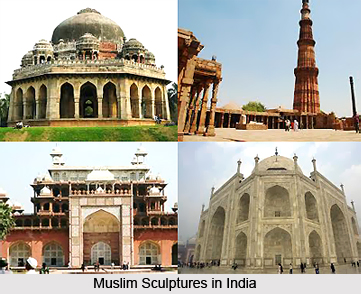 Muslim Indian sculptures played an important role in the development of Indian art and architecture. Historical facts have often pointed out that Muslim invaders have plundered ancient Indian temples. Simultaneously it is also true that the Muslim rulers of India have constructed beautiful monuments and enriched the art and culture of India. Throughout the Muslim rule in India wonderful monuments have been constructed that are famous even today. These monuments still stand as logo of creativity while displaying the finesse of the Muslim Indian sculpture. Taj Mahal is one such glaring example of Muslim sculpture; built in white marble it been recognized as one of the Seven Wonders of the World.
Muslim Indian sculptures played an important role in the development of Indian art and architecture. Historical facts have often pointed out that Muslim invaders have plundered ancient Indian temples. Simultaneously it is also true that the Muslim rulers of India have constructed beautiful monuments and enriched the art and culture of India. Throughout the Muslim rule in India wonderful monuments have been constructed that are famous even today. These monuments still stand as logo of creativity while displaying the finesse of the Muslim Indian sculpture. Taj Mahal is one such glaring example of Muslim sculpture; built in white marble it been recognized as one of the Seven Wonders of the World.
The Muslims came and conquered India. They brought with them their own dogmas and styles. Their Persian style of architecture intermingled with the native form and gave rise to a new form and a whole new concept of the Indo -Islamic architecture. Initially, however, the Muslim Indian sculptures followed a different style but in the later years the features of the Muslim Indian sculpture and architecture differed. One of the main elements that this style introduced was the dome element. Whether it was a religious building or a secular one, domes were always an important part.
Another important feature of Muslim Indian sculpture is the Pietra Dure inlay work. This is a decorative art where stones are exquisitely cut and fitted within inlay works. These stones varied from semi precious to precious. The sculptures from the Muslim reign show intricate works and details. Foliage sculpture, especially creepers are quite commonly found in these monuments. The Muslim era in Indian can be divided into two: Delhi Sultanate and Mughal dynasty.
The features of Delhi Sultanate sculpture primarily reflect the early Muslim features. Minarets, lofty minars, tomb structures, jail windows and other architectural elements are quite apparent from the buildings. It was the Mughal architecture that primarily incorporated both the Persian and Hindu styles of architecture. Another important feature of Mughal sculptures is calligraphy. The walls of mosques, memorials and tombs usually have this sculptural element. The trend of quoting Holy Quran is quite common. Besides arabesque is also a recurring element in Islamic sculpture. Arabesque is the art of repeating geometric forms of plants or animals. Indian Muslim sculptures usually have the plant pattern.
However it would be wrong to say that the only change in the field of art occurred in Indian Muslim sculptures. This impact was also felt in painting, music and even in Indian dance.



